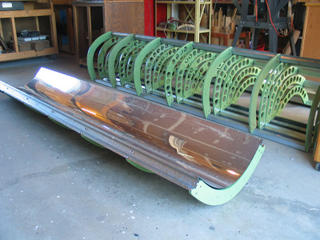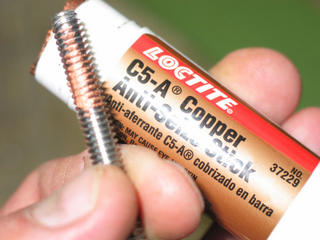 Collector tubes are the "business end" of this DIY tracking solar concentrator project. The collector tube at the focus of each reflector absorbs and conducts the sun's heat to the water which travels through it.
Collector tubes are the "business end" of this DIY tracking solar concentrator project. The collector tube at the focus of each reflector absorbs and conducts the sun's heat to the water which travels through it.Shown here are four copper collectors and one glass/copper collector that I made to test as a concentrated UV sterilizer.
The black coating on the copper is ordinary matte black high temperature spray paint, like Tremclad or the local house brand. I found that the most efficient way to coat the tubes was to line them up like this between the supports and blast them with paint from a spray can. In this way, I could aim the spray toward one tube, travel down that tube to the end and then move back along the next tube trying to get an even light coat with no drips. The overspray from one tube would then fall on the tubes behind it. When that pass was dry to the touch, I'd rotate the tubes about 60 degrees and paint another pass. With a bit of practice, I could coat the tubes with a uniform looking two coats of black in about six passes.
I'd considered and tested many different types of tubing. The tubes needed to conduct heat well, be strong and resistent to sagging, not burn up in the case of a failure, and must be easily joinable to a conventional PVC plumbed system.
The collector tubes must span 8-1/2 feet between the supports. As well as it's own weight, each tube supports it's reflector and the weight of the water within it. With the 1-1/2 inch diameter size I'm using, that's about 10 pounds of water that is contained in each tube over its length.
I'd built a temporary test setup with two sawhorses spaced parallel 8-1/2 feet apart and measured the sag of various tubing. This involved placing each tube across the top of the sawhorses and putting a 90 degree elbow on both ends, facing up, so that I could fill each sample tube with water. To keep them from rolling around, I placed each tube in a metal V block on the top of each sawhorse. A plumb bob was hung from the center of the tube and the distance from the tip of the plumb bob to the ground was measured with a small ruler to an accurancy of about 1/2 mm.
It became apparent pretty quickly that any plastic tube had way too much sag over this distance and with this weight. If used as a collector the plastic pipe would sag out of focus. The copper tube sagged only about a millimeter, which was surprisingly good and almost less than I could measure. Copper tube also felt very "stiff" when I pressed down at the center while the plastic tube "gave" quite a bit.
The plastic tubes (both ABS and PVC) sagged as much as 10-15 millimeters. Worse than that was their "memory" and their lack of inherent straightness particularly if your home center keeps their tube inventory in vertical racks. The PVC tube was the worst in this regard and even selecting carefully, I found it hard to buy tubes that looked at all straight.
For this solar heater project, I've settled on the use of copper tubing for the collectors but glass is still being looked at for a sterilizer variation.
 The copper tubing of this size at your typical home center or hardware store is DWV type (or Drain Waste Vent). This is what I started with. There are other grades of copper tube available at plumbing supply houses that might be an even better choice.
The copper tubing of this size at your typical home center or hardware store is DWV type (or Drain Waste Vent). This is what I started with. There are other grades of copper tube available at plumbing supply houses that might be an even better choice.In this picture (click to enlarge) you can see the difference between DWV tubing (at the top) and M-type copper (on the left) and L-type copper (on the right). DWV is intended for low pressure and temperature. M-type is sold for regular waterline and L-type is for high temperature. You can see the significant difference in the wall thicknesses here. I'm not sure yet if the composition of the copper alloy is different between the three types but I've heard it might be. When you carry them, you can feel that the DWV is "lightweight" compared to the other two.
I have used a combination of the three types in the current assembly of the concentrator and will make further comments as I progress. Any of the three types of copper could be used. As you might expect, both M and L types are significantly more expensive that DWV (about twice) although there isn't as great a difference in cost between them.




